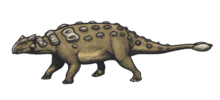Gigantspinosaurus
| Gigantspinosaurus Temporal range: Late Jurassic | |
|---|---|
| Scientific classification | |
| Kingdom: | Animalia |
| Phylum: | Chordata |
| Clade: | Dinosauria |
| Order: | †Ornithischia |
| Suborder: | †Stegosauria |
| Genus: | †Gigantspinosaurus |
| Type species | |
| Gigantspinosaurus sichuanensis Ouyang, 1992 | |
Gigantspinosaurus (meaning "giant-spined lizard") is a genus of herbivorous ornithischian dinosaur from the Late Jurassic. It was a stegosaur found in Sichuan, China.
The first fossil was found in 1985 by Ouyang Hui at Pengtang near Jinquan and was reported upon in 1986 by Gao Ruiqi and colleagues, mistaking it for a specimen of Tuojiangosaurus.[1] The type species, Gigantspinosaurus sichuanensis, was described and named by Ouyang in 1992 in an abstract of a lecture.[2] The generic name is derived from Latin gigas or giganteus, "enormous", and spina, "spine", in reference to the gigantic shoulder spines. The specific name refers to Sichuan.
The name was generally considered a nomen nudum in the West,[3] until in 2006 it was disclosed that the abstract contained a sufficient description.[4] Despite its uncertain nomenclatural status, images of Gigantspinosaurus had appeared in several sources. Public awareness of this animal was increased in early 2006 when Tracy Ford,[5] considering it a validly established taxon, published a short article on reconstructing it. Ford suggested that earlier reconstructions of Gigantspinosaurus attached the shoulder spines upside-down, and his new reconstruction shows the spine extending somewhat upwards, ending higher than the top of the animal's back. Susannah Maidment and Wei Guangbiao in 2006 concluded that G. sichuanensis was a valid taxon in their review of Late Jurassic Chinese stegosaurs, but did not redescribe it because at that time it was under study by Zigong Dinosaur Museum staff.[4] In fact, a Chinese redescription by Peng Guangzhao and colleagues in 2005 would predate Maidment's publication.[6]
The holotype, ZDM 0019, was found in layers of the Upper Shaximiao Formation of Zigong (Sichuan province), which date to the Oxfordian. It consists of a partial skeleton of a probably subadult individual missing the skull (though the lower jaws are present), hind feet, and the tail end. Apart from skeletal elements also plates, spines and scutes have been found. At the left shoulder an impression of the skin had been preserved. The specimen is part of the collection of the Zigong Dinosaur Museum and has as a mounted restored skeleton been on display since 1996. In 2005 Peng e.a. reported a second specimen, ZDM 0156, a pelvis found at Chenjia near Fuquan.

Gigantspinosaurus was described by Peng and colleagues as a "medium-sized stegosaur". It was estimated by Gregory S. Paul in 2010 to have been about 4.2 metres (14 ft) long and 700 kilograms (1,500 lb) in weight.[7] Gigantspinosaurus has a distinctive appearance with relatively small dorsal plates and greatly enlarged shoulder spines, spinae parascapulares, twice the length of the shoulder blades on which they rested via large flat bases. The plates on the neck are small and triangular. The head must have been relatively large with thirty teeth in each lower jaw. The hips are very broad and the low neural spines of the four sacral vertebrae and the first tail vertebra have been fused into a single plate. The forelimbs are robust.
The skin impressions were described by Xing Lida and colleagues in 2008. They cover a surface of 414 square centimetres (64.2 sq in) and show rosettes with a central pentagonal or hexagonal scale surrounded by thirteen to fourteen ridged smaller square, pentagonal or hexagonal scales with a diameter of 5.7 to 9.2 millimetres (0.22 to 0.36 in).[8]
A study by Maidment indicated that Gigantspinosaurus is the most basal known member of the Stegosauria.[9] Peng and colleagues, however, placed it in the Huayangosaurinae.
See also
References
- ↑ Gao, R., Zhu, S. & Huang, D. 1986. [Chinese] [The discovery of some stegosaurian shoulder spines in Zigong Municipality]. Vertebrata Palasiatica 24: 78-79
- ↑ Ouyang, H. (1992). "Discovery of Gigantspinosaurus sichanensis and its scapular spine orientation". Abstracts and Summaries for Youth Academic Symposium on New Discoveries and Ideas in Stratigraphic Paleontology (in Chinese). null: 47–49.
- ↑ George Olshevsky (1995-11-07). "Dinosaur Genera List corrections #19". Retrieved 2007-03-02.
- 1 2 Maidment, Susannah C.R.; Wei, Guangbaio. (2006). "A review of the Late Jurassic stegosaurs (Dinosauria, Stegosauria) from the People's Republic of China". Geological Magazine. 143 (05): 621–634. doi:10.1017/S0016756806002500.
- ↑ Ford, Tracy L. (2006). "Stegosaurs: Plates, splates, and spikes, part 1". Prehistoric Times. 76: 20–21.
- ↑ Peng, G., Ye, Y., Gao, Y., Shu, C.-K., & Jiang, S., 2005, Jurassic Dinosaur Faunas in Zigong, Zigong, Sichuan Scientific and Technological Publishing House, 236 pp
- ↑ Paul, G.S., 2010, The Princeton Field Guide to Dinosaurs, Princeton University Press p. 222
- ↑ Xing, L.D., Peng, G.Z. & Shu, C.K. 2008. "Stegosaurian skin impressions from the Upper Jurassic Shangshaximiao Formation, Zigong, Sichuan, China: a new observation". Geological Bulletin of China 27: 1049-1053
- ↑ Maidment, Susannah C.R. (2006). "Systematics and phylogeny of the Stegosauria (Dinosauria, Ornithischia)". Journal of Vertebrate Paleontology. 26 (Supplement to Number 3): 94A. doi:10.1080/02724634.2006.10010069.

